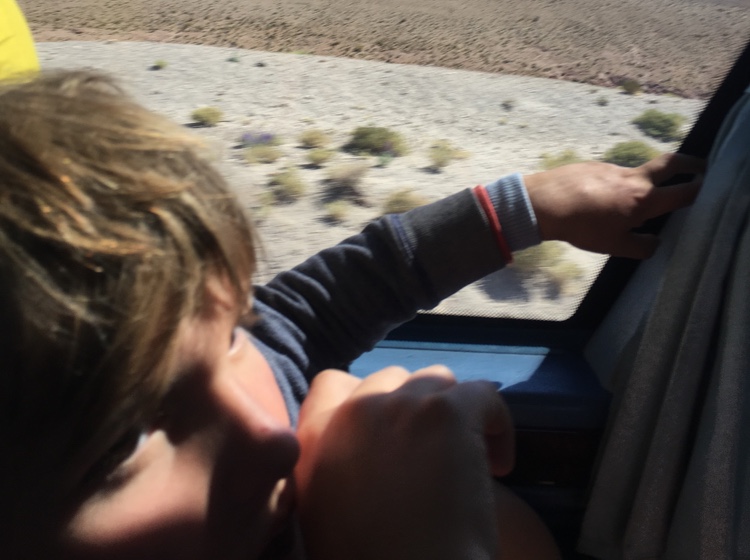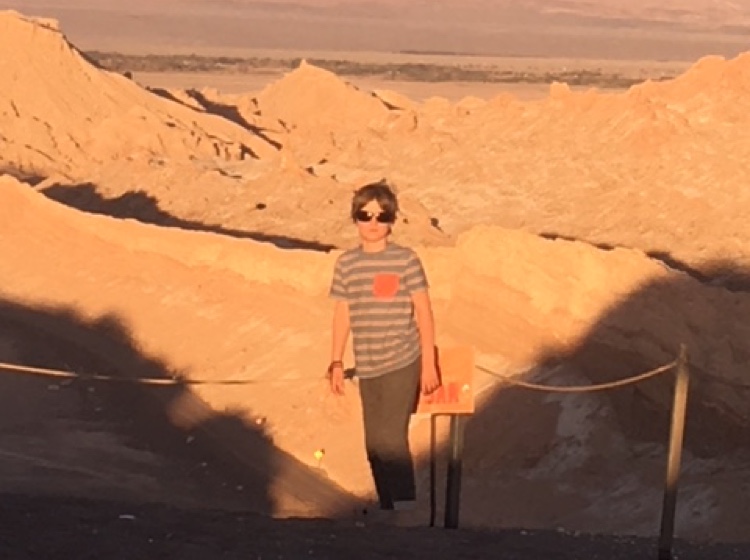Okay, we’re playing catch up here…Bear with us. This is more than you will want to know about our trip to the Galapagos Islands, but given the condensed, quick nature of our tour, we wanted to have a record of the places we went and the animals we saw.
6/29 – Boarded our boat, the Legend, and was overwhelmed by the sheer luxury of it. My, how we have come up in the world. From the modest apartment in the Centro Historico, to the luxury (and heated pool) of Hotel Quito, to this…
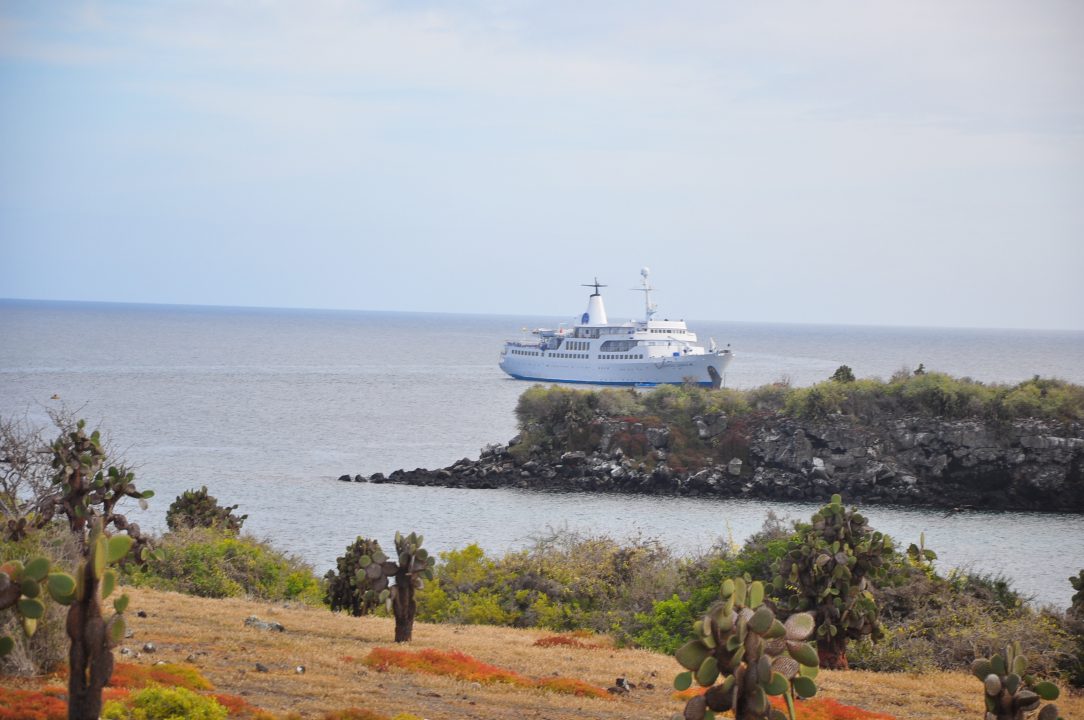
Sarah made all the arrangements and for various reasons, including her disposition to seasickness, booked us passage on the Legend, a 100-passenger cruise ship, and because she signed us up early, we’re staying in these adjoining cabins each larger than NYC hotel rooms with king-size beds and balconies over the ocean and even a refrigerator containing champagne.
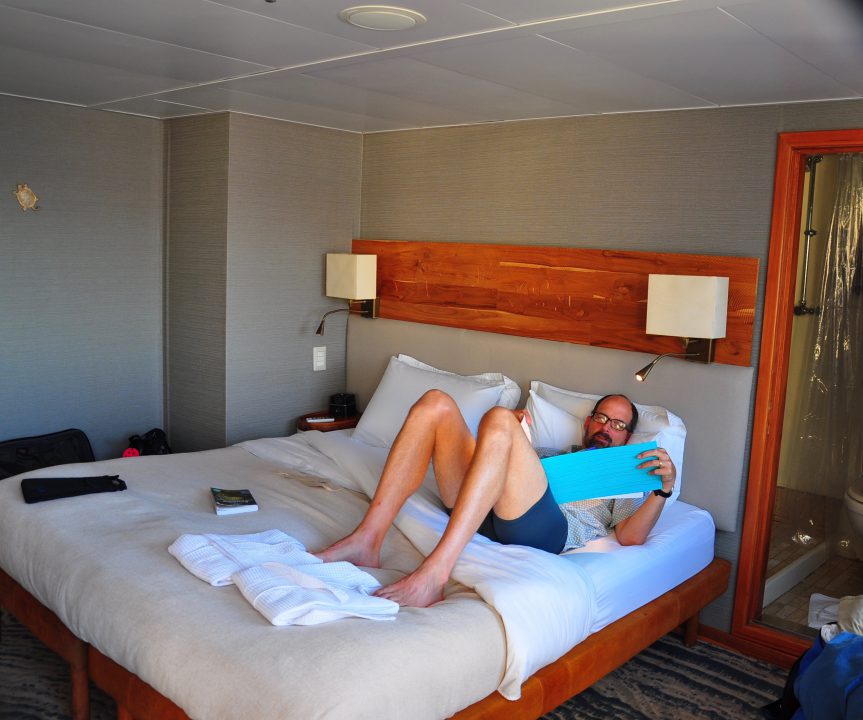
So this is what some people think of when they think of travel. Unfortunately, I could get used to it.
I’ve always shunned cruises in general, mostly because they take a lot of free will out of travel. For me traveling has always been about being able to make my own mistakes and not having a tour operator do it for me. But the Galapagos are a necessary exception, in that you must be accompanied by a national park guide wherever you go (because of the fragile ecosystem).
After two weeks of free-for-all tourism in Quito, I have to say it’s a relief to get on this boat and have everything decided for us, as well as have all our meals prepared for us (there’s even a separate kid’s menu with pizza and chicken fingers). I’m realizing that for my peace of mind, we may have to mix our own free-form agenda with tours and other more structured forms; it’s nice to go back and forth between the two.
Our bus from the Baltra airport to the boat almost ran over several land iguanas, our welcoming party. Once on board the Legend, we were divided up into our various groups with which we would explore the islands. Our group of 15 was called the Iguanas. We were disappointed we didn’t get to be one of the Boobys. We knew it would get a laugh from Julian each time they called us to the disembarkation area. After lunch, we took an excursion to Mosquera Islet with the rest of our group. Our guide and leader is Gustavo, a handsome, charming native of the Galapagos who quickly worked his way into our hearts. My fear that we’d get a guide who can’t speak English and/or make things interesting for the kids (the Guayasamin Museum in Quito being the trip’s sterling example of this – we had a guide with poor command of English AND a speech impediment, and the kids were bored immediately) seems for now unfounded. Gustavo considers all of Julian’s questions and comments thoughtfully and seems to see that he sometimes needs to be the guide.

The islet was nothing more than a large white-sand beach. We saw Sally Lightfoot crabs – psychedelic crustaceans of red, orange, yellow, green, and blue – on the rocks like a bloom of poppies in the middle of the moon.
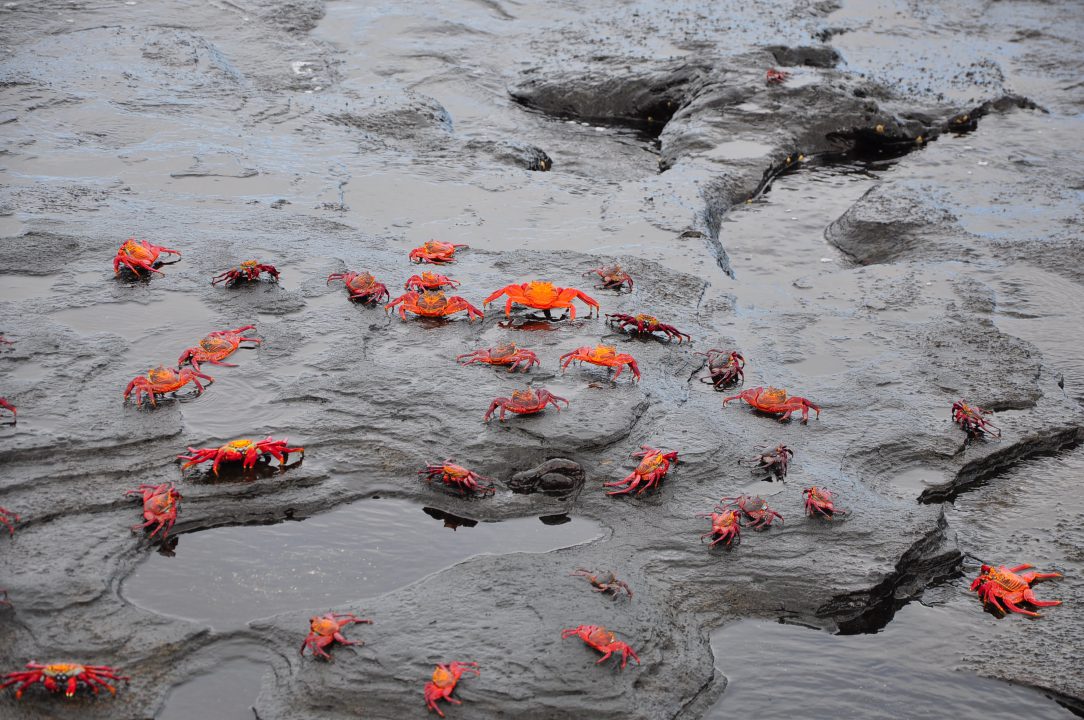
Sea lions as well were everywhere, waddling around us as if we were part of the landscape. To call them “tame” isn’t accurate – they just don’t care about us at all.
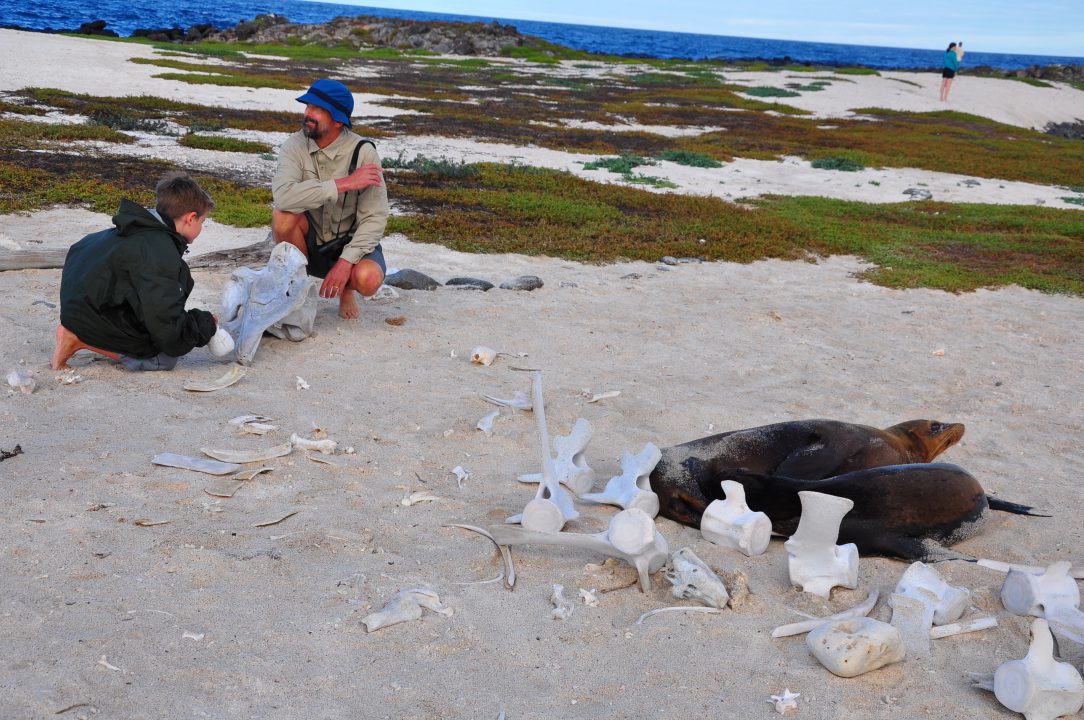
We also saw bones. Lots of bones. One thing you realize when you visit the Galapagos, where no one is allowed to touch anything, is how many bones we don’t see in most of our wilderness areas. You’re constantly reminded of death as well as life — the Galapagos is as much a cemetery as a nursery.
On the life side:
Yellow warblers
Frigatebirds (which turn out to be as common as gulls here)
Red-throated lizards
An American oystercatcher
And a small humpback whale skeleton! (See photo above.)
(try singing the previous list to “The 12 Days of Christmas”)
Rough seas the first night. Woke periodically to the clatter of things falling over. Getting up to go to the bathroom was worse than a three-martini night. In Julian’s words: “I woke up and I had to grab onto my dad to keep from falling out of the bed.” The good news is that neither Sarah or Cleo got sick, which bodes well for the rest of the trip.
6/30 – Egas Port in Santiago Island in the morning: a hike, followed by snorkeling. The beach was black sand. We saw:
Marine Iguanas (with faces like ancient old men)…
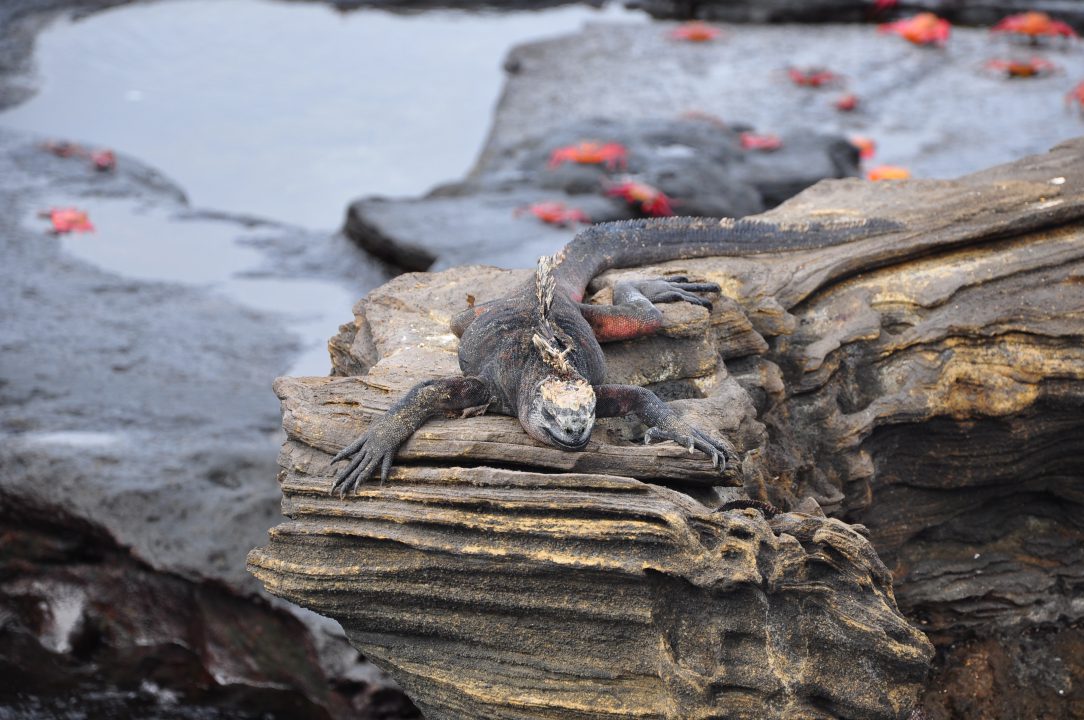
More Sally Lightfoot crabs, more sea lions (including a baby staggering out of the surf)…
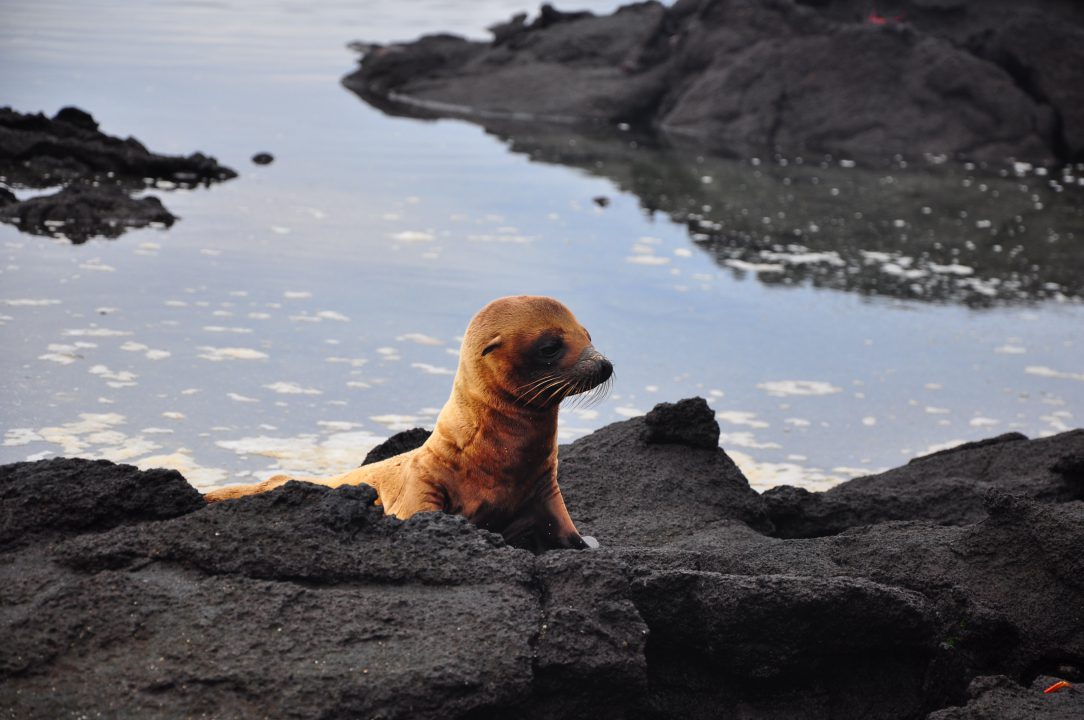
…red-throated lizards, yellow warblers–
Galapagos mockingbirds (similar but looks different and sound different than the ones that hang out in our L.A. backyard)
Galapagos hawk
Terns
Blue-footed booby (their feet are a beautiful shade of sky blue)…
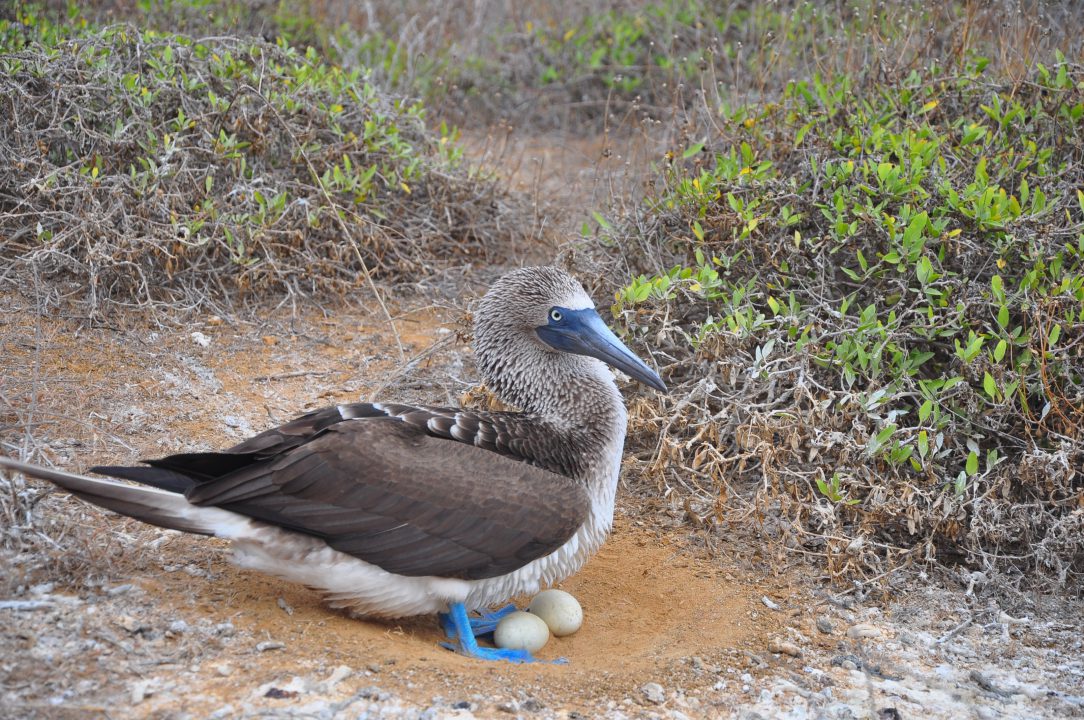
Galapagos dove
Darwin finch
Another American oystercatcher…
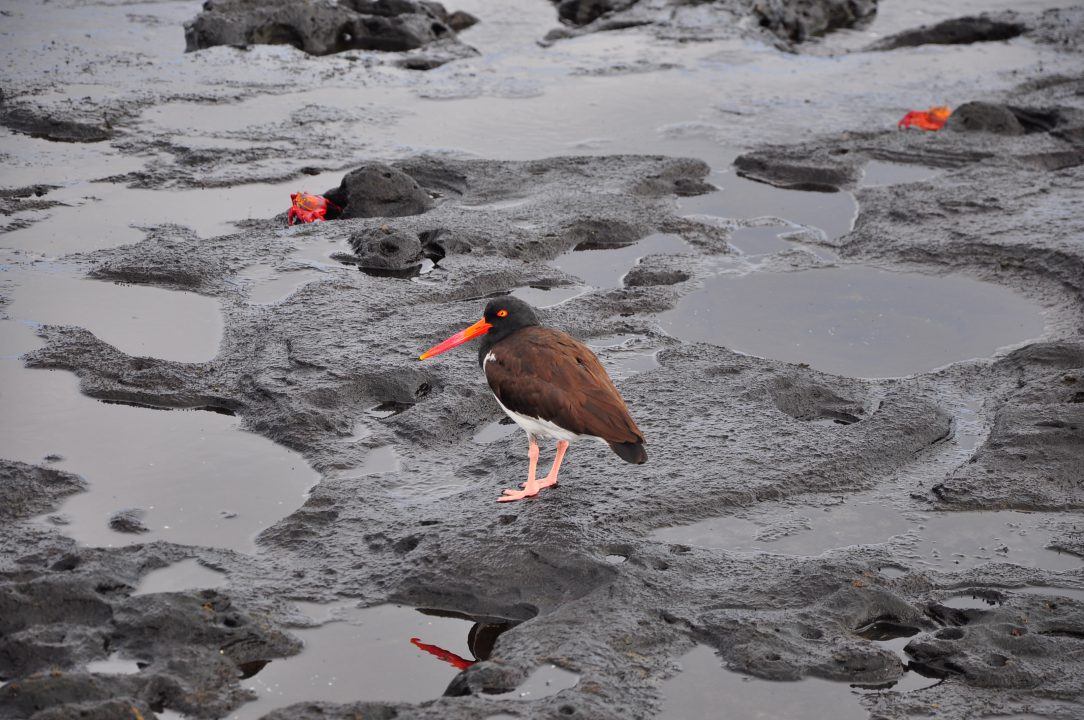
Sea lions in the water
While snorkeling we saw:
A large Manta Ray (lodged in an underwater crevice of coral like a Volkswagen parked in a garage)
Our first green sea turtle.
In the afternoon, on Rabida island, which featured a red-sand beach, we hiked.

We saw cacti that have adapted soft thorns because they have no predators. The soft thorns help encourage reproduction – bees and birds can more easily access the fruit and seeds.
We climbed and looked down upon a steep cliff with ocean waves crashing against it.
We smelled the leaves of the holy stick tree – full of citronella
We spotted a orange-brown-white grasshopper. Gustavo explained that there are not many insects this time of year because they use the rainy season to hatch, eat, grow, and lay eggs. This season (dry season) is the dormant season, the winter, for most insects.
So far, in just two days, we’ve been on a white sand beach, a black sand beach, and a red sand beach.
We also saw this sea lion pooping in the ocean. (This is the kind of thing that’s keeping Julian in the game.):
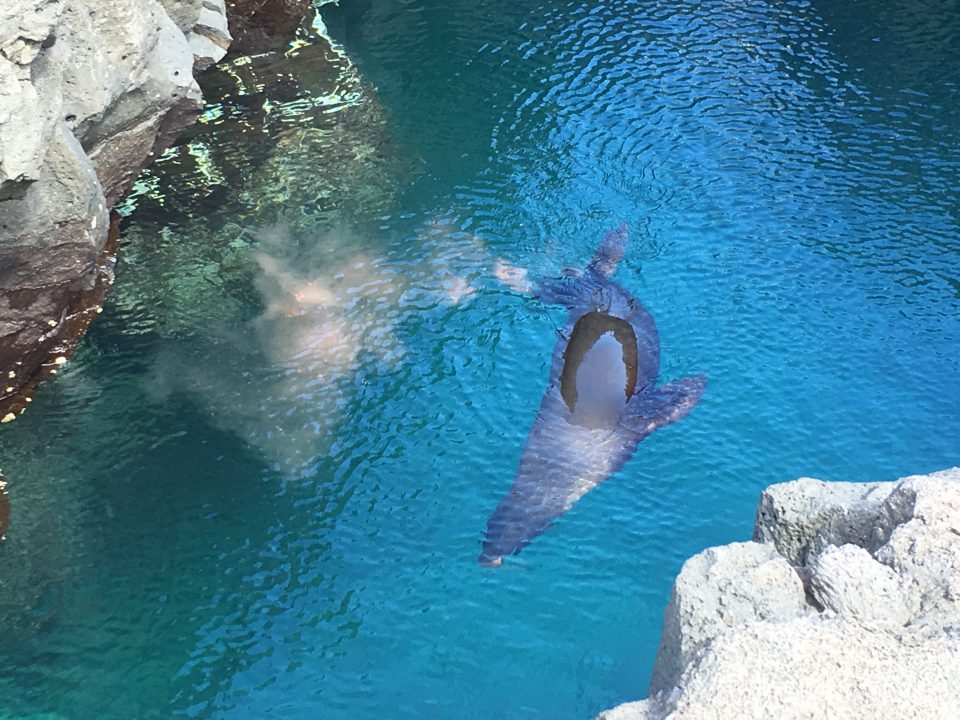
Dora is the real character of our Iguanas group, an older Chinese-Canadian lady who sasses off to everyone. She’ll interrupt Gustavo’s Spanish version of his spiel with “I CAN’T UNDERSTAND YOU!” She dotes on the kids and insists on having her pictures taken with them in front of every large reptile.
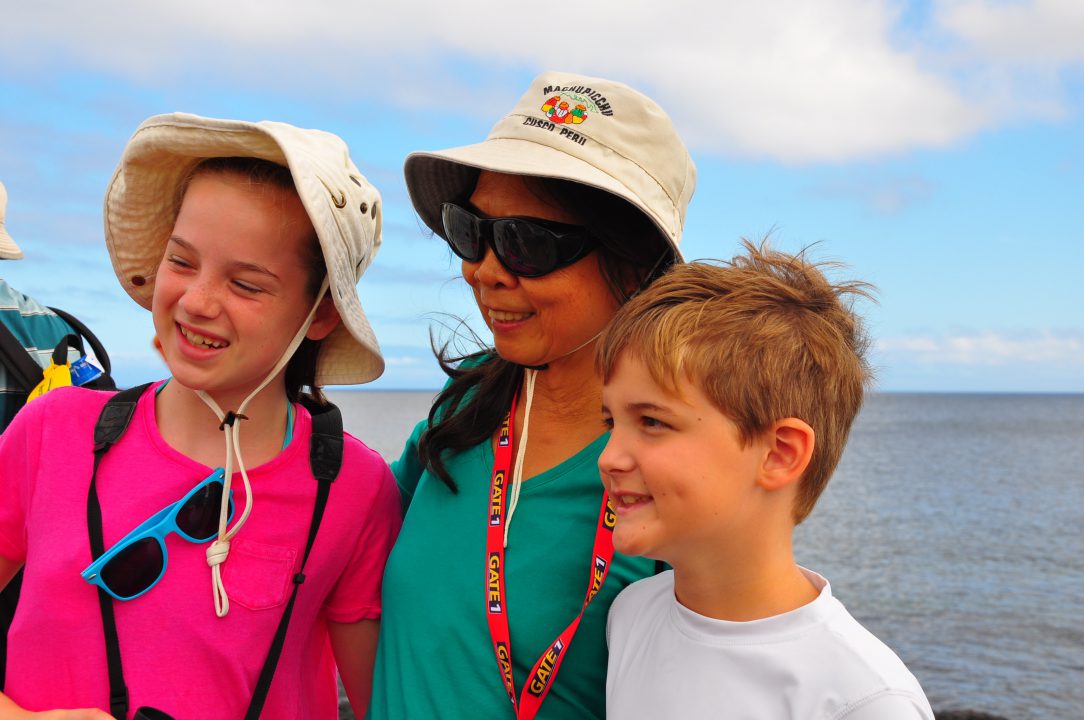
When we were coming back from the island, she jumped into another group’s dinghy and didn’t tell anyone. We were speculating what she should do if she were left behind. Julian said, “In a thousand years, a new species would emerge.” Everyone cracked up.
An extroverted bald Canadian named Andre (also a character) leaned on Julian when he almost stepped on a lizard. They were joking back and forth about how Julian saved him and at one point Julian said, “It’s not like I messed up your hair.” Andre was tickled but pretended to be deeply injured by this comment.
After two days, Julian has grown fatigued by the constant activity of the trip and is begging for down time. The schedule is packed from early morning to night. I have to convince him to keep coming out with us because I know he’ll regret missing some of these animals and sights. His deepening friendship with our guide Gustavo definitely helps. One thing I always remind him is that, “Gustavo is counting on you to help him on the tour,” as well as, “All the Iguanas will miss you.” I keep telling him, “This is the island we’ve been waiting for!” and wonder when he’ll realize I’ve been saying that about every island.
7/1 – Urbina Bay on Isabela Island in the morning. Landing on a beach. Saw our first Galapagos Tortoise just up the trail.
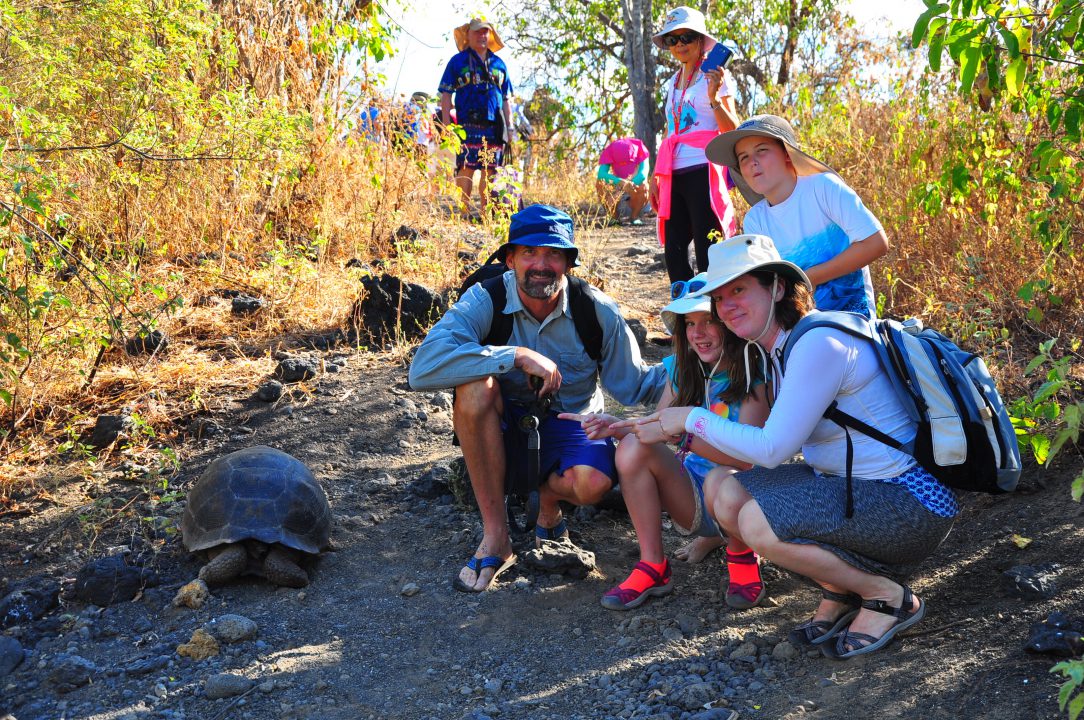
It was pretty big but “only” 80 years old (they can live to be 200). It was sitting in its own pee. One hour later, when we were coming back down the trail, we checked in on it and saw that it had moved about one inch from its pee. Perhaps lolling in your excrement is one key to longevity. I’m in.
We saw our first land-based iguana moments after the first tortoise. Huge and beautiful yellow and orange coloring. So much like a dinosaur that we might as well call it one.
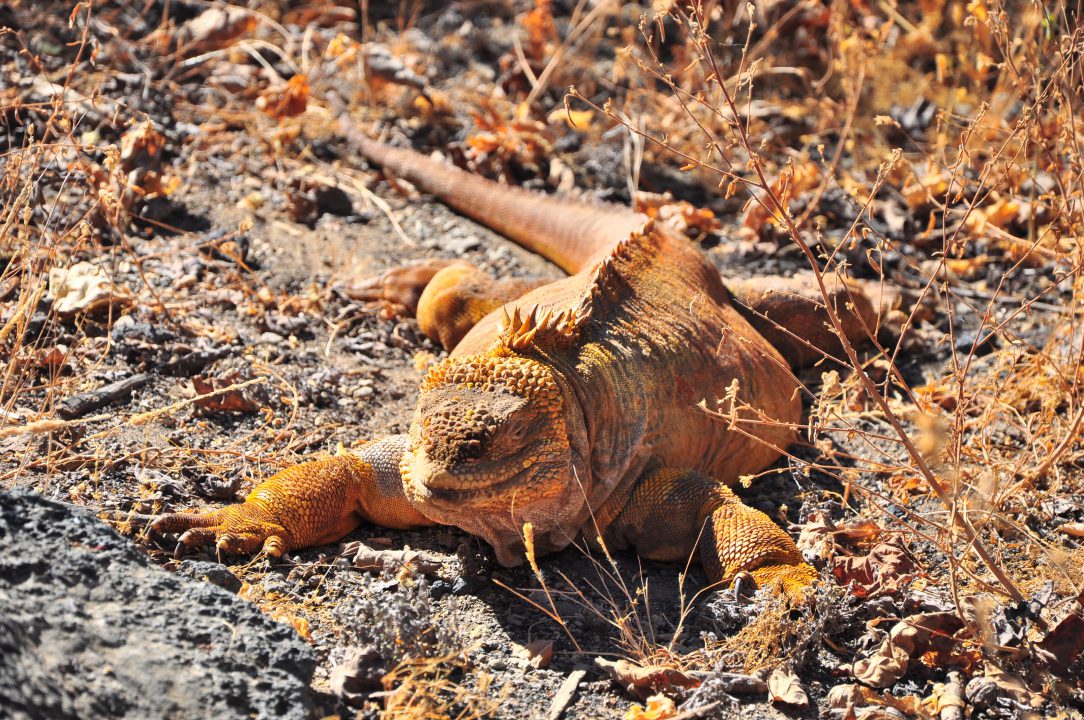
Later we saw one running through the undergrowth. The movements of its four limbs were astonishing. I‘ve just never seen anything move like that outside of a horror film.
This place was all about giant tortoises and land iguanas, and it delivered. Afterwards we snorkeled in a beautiful sandy cove and the kids got to see a ton of green sea turtles along with loads of fish. Later in the afternoon, Sarah and I left the kids alone with their video games on the boat and did a deep-water snorkel off the dinghy, where we saw our first Galapagos penguins swimming in the water and the famous flightless cormorants fishing underwater. The penguins possess cartoon-like speed: One moment they’re hovering in the water in front of your face mask; the next they’ve disappeared out of sight. They’re little torpedoes.
The revelation of the trip so far has been the snorkeling.
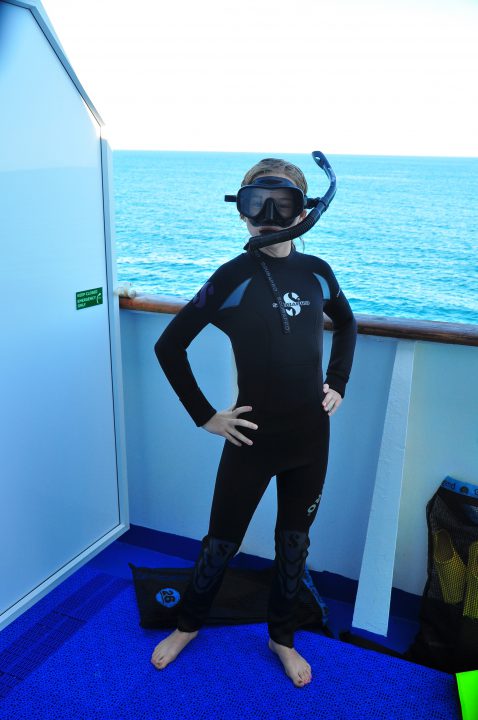
While the flora and fauna on the land are exotic, they’re not diverse. The biodiversity beneath the ocean, however, is incredible. While the land is often volcanic rock and scrub brush, below the water it’s a brilliant green like Irish hills populated with fish of bright orange and yellow and massive schools of black, blue and silver fish, not to mention swimming mammals, birds and reptiles, all of whom have adapted to take advantage of where it’s all happening. (In the case of the cormorant, it meant giving up the ability to fly in exchange for the ability to dive deeply. Watching one of these birds fish is like watching a sea serpent.)
Before dinner, we went to Tagus Cove, also on the island of Isabela, which was in pre-national park days a whaler/pirate harbor (graffiti on the rock walls dates back to 1834). After a thirty-minute walk inland, we reached Darwin Lake, an inland body of water that combines seawater and rain water (Darwin, exhausted and overheated after a day of making humanity-changing observations, famously came to the lake excited to have a drink and was horribly disappointed to taste brackish water.) The walk was all about the dramatic scenery (that’s our boat in the background).
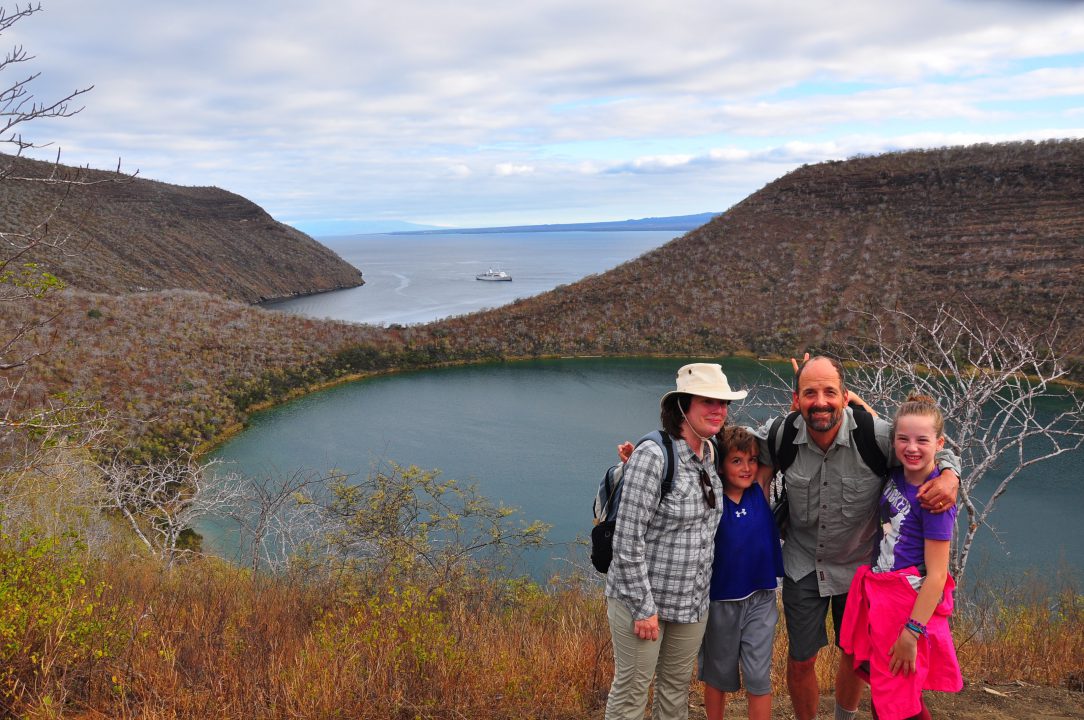
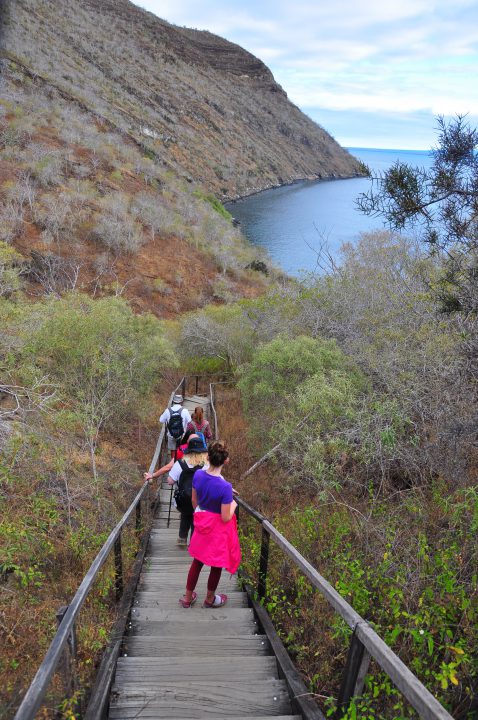
Afterwards, we rode around in a dinghy to find penguins, which we found (fleetingly) hopping through the water after fish like dolphins. These combined with the pelicans and blue-footed boobies repeatedly dive-bombing into the water made for spectacular viewing, though Julian became quickly bored (maybe if it was a video game?).
7/2 – Fernandina Island is the newest addition to the Galapagos archipelago, created by a volcano around 500 years ago. We woke at an ungodly hour and jumped in dinghies. The approach was impressive, early morning light breaking through the clouds as we rode through a mangrove swamp tunnel to a landing rock. The wildlife on this island was the most spectacular to date – no new species, but babies of almost everything. We saw dozens of sea lion pups (some only a day or two old) and sadly, one dead one (the sea lion mother lay next to the pup corpse and Gustavo said she would stay near it for a week before going back into the sea). Cleo was on a roller coaster, freaking out over the cuteness of the living pups and mourning the tragedy of the dead one. We also saw baby marine iguanas, a baby manta ray in the water as we were landing, and a baby racer snake curled under a rock. The youngest island, it turned out, was also the host to the youngest animals.
There were also piles upon piles of marine iguanas, covering the rocks (and each other) like strange statues. The smell of iguana dung announced each colony before we actually saw it.
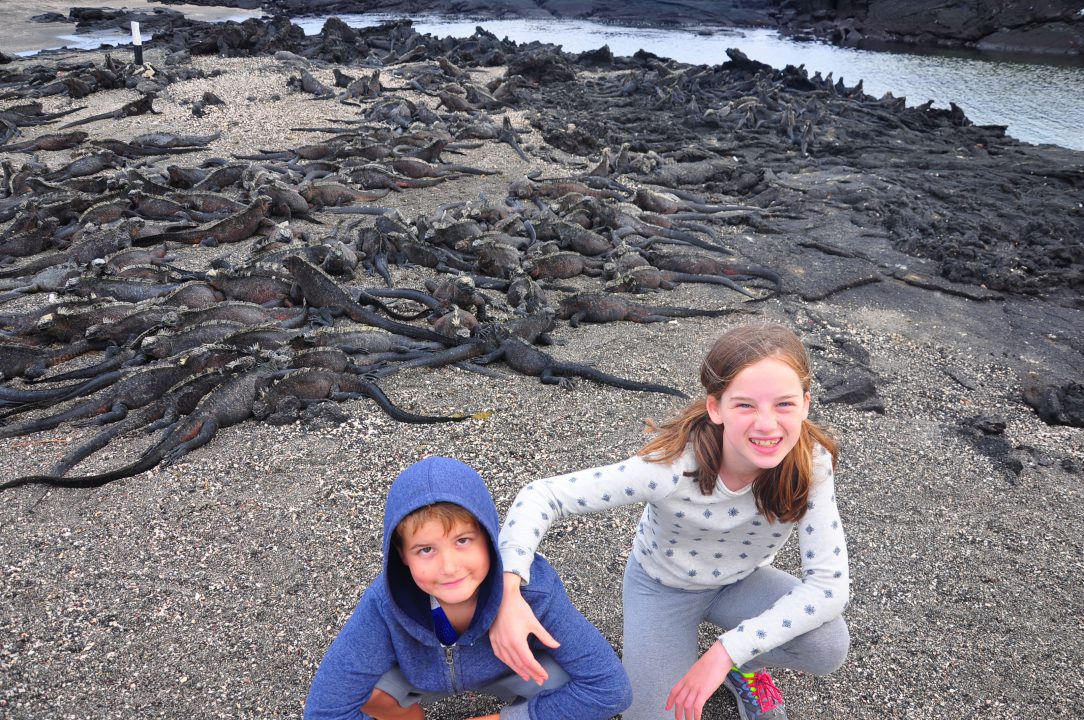
Towards the end of our walk, we came upon the bleached bones of a whale, a dramatic contrast to the black lava rock.
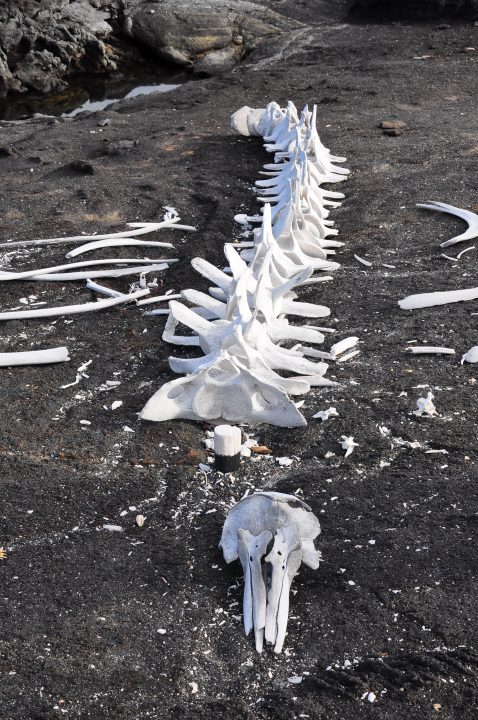
In the dinghy back to the boat, we saw whales spouting up ahead and made a detour to intercept a blue whale on its migration. There’s probably been nothing more exciting on the trip so far as the sight of that wet black skin adorned with small fins and the white spout.
A quick change, then it was time for a deep water snorkel, our first with Julian and Cleo along. The kids did amazingly well, given the relatively cold and choppy water. Gustavo offered to join us to help us with the kids and Julian was his snorkeling buddy. We saw tons of green sea turtles among myriad other fish. Also a glimpse of an orange octopus (pulpo) before it retreated into a crevice.
But the highlight of the trip so far was the deep-water snorkel after lunch (on Isla Isabela). It was a demanding, technically difficult swim along cliffs and into a cave, and the kids handled it with aplomb. Cleo and I were buddies, as were Sarah and Julian. The drama of seeing the hunting birds from above and below the water was intense; we were also escorted by playful fur seals (smaller than the sea lions with ear slits instead of external ears) that wove around us in the water; and I’ve never seen so many sea turtles in my life – there were a couple points where I felt somewhat claustrophobic because there were so many of them. We also snorkeled by colonies of marine iguanas and saw them swimming in the water (with amazing grace considering their awkward shuffling on land). As we came around the point, I heard our guide excitedly yelling. I couldn’t hear exactly what she was yelling, but I knew the tone of voice from years of diving and snorkeling. I grabbed Cleo’s hand and kicked into high gear, pulling her across the small bay. (Cleo later said she thought there might be some emergency.) We ran smack dab into a huge sun fish, a spectacularly odd creature with one fin up and one fin down. Here’s a photo (not ours) of this prehistoric vestige:
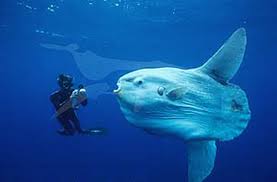
Coming into close contact with such an animal was a great experience for us. We’d seen one earlier in the trip from the surface, but looking it in the eye was another experience, a quick glimpse of something mysterious and unexplainable.
Later in the afternoon we retraced our snorkeling in a dinghy, including the cave, and it was fun seeing it from the perspective of being above the water. We added the Nazca booby to our list of birds. We’ve now seen two boobies! (Hold for laugh.)
Stay tuned to see if we discovered the third booby – the Red Footed!


